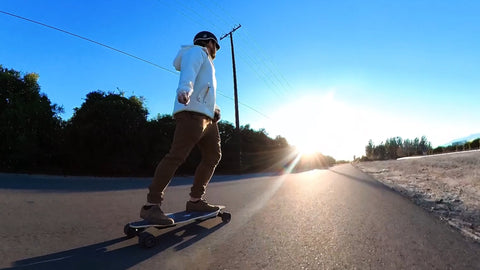Beginner's Guide: What You Should Know About Electric Skateboard Deck Material?
Choosing the right electric skateboard that fits your riding style is important, the deck materials would affect the riding experience and performance of the electric skateboard. If you don't know how to select the deck material suited to your riding style, this blog will help you make an informed decision. We will explore the common deck materials and how to select the right electric skateboard deck.
Common Materials Used for Electric Skateboards
1. Maple Wood
Maple wood is one of the most popular choices for electric skateboard decks. It's known for its sturdiness, durability, and ability to absorb shock. Maple decks are often used for their responsiveness and pop, making them a common choice for electric skateboards.
Pros:(1) Durability and Sturdiness
(2) Excellent Load Capacity
(3) Fit for rugged use
(4) Guaranteed to last long
(1) Heavier Weight
(2) Stiffer than Bamboo
(3) Longer replenishment time of raw material
2. Bamboo
Bamboo decks are lightweight and flexible, providing a smooth and comfortable ride. Bamboo is always in combination with other materials to customize a new desired deck, such as maple or fiberglass. They can add strength to the deck and provide flexibility for the riding experience.
Pros:(1) Flexibility
(2) Sustainability
(3) Lightweight and Portable
(4) Good Shock Absorption
(5) Lighter for doing tricks
(1) Not as durable as maple.
(2) Lower Load Capacity
(3) Slightly worse in durability
3. Fiberglass
Fiberglass is often used as a material to reinforce the deck, such as bamboo or maple. It can add strength and stiffness to the deck without significantly increasing its weight.
Pros:(1) Enhance durability.
(2) Lightweight and Sturdy
(3) Good shock absorption
(1) Expensive
4. Carbon Fiber
Carbon fiber decks are known for their extreme durability and lightweight properties. They offer excellent stiffness, which can enhance stability at high speeds. High-performance electric skateboards are always used carbon fiber as deck materials.
Pros:(1) Long-lasting and Durability
(2) Lightweight and portable
(3) Excellent stiffness for high-speed stability.
(1) Expensive Cost
(2) Less Flex
5. Composite Materials
Some electric skateboard decks use composite materials that combine different layers of wood, bamboo, fiberglass, and carbon fiber to form a desired performance deck. These decks are designed to offer a balance of strength, flexibility, and weight. Different combinations of different materials will have different features of the deck. Specific materials and construction techniques would affect composite deck quality and performance. When choosing a composite deck electric skateboard, you should consider the brand reputation and the quality of construction.
Pros:(1) Balance the advantages of different materials
(2) Customize based on the desired performance.
(1) Varied Quality

Bamboo + Fiberglass Flexible Deck of Uditer Electric Skateboard
The excellent shock absorption flexible deck of Uditer Board consists of 3 layers of bamboo + 2 layers of fiberglass. Bamboo provides a comfortable riding experience, and fiberglass provides strength and stiffness to the deck, keeping the deck relatively lightweight, flexible, and sturdy. The Bamboo+fiberglass deck is suitable for long commuting and cruising around.

What Factors Should I Consider to Choose Electric Skateboard Deck Material?
• Riding Style
Think about your riding style and preferences. Are you interested in cruising, commuting, or performing tricks? Maple decks excel in pop and durability, making them ideal for tricksters, while bamboo offers a smooth, comfortable ride for cruising.
• Terrain
Consider the type of terrain you'll be riding on. A flexible bamboo deck might be more forgiving if you plan to tackle rough roads or uneven surfaces. On the other hand, if you'll be primarily riding on smooth pavement, a stiffer deck like carbon fiber could be suitable.
• Weight and Portability
Think about how you'll transport your electric skateboard. Bamboo composite decks and carbon fiber are lightweight and easy to carry, making them great for commuters. Maple decks are heavier than bamboo composite decks.
• Budget
Your budget will influence your options. Maple decks are often more budget-friendly, the price of composite decks would be affected by their combination materials, while carbon fiber decks tend to be at the higher end of the price spectrum.

Conclusion
By understanding the features, pros, and cons of these common materials of electric skateboard decks, you can make an informed choice that aligns with your riding style and preferences. Each material has its advantages and disadvantages, making it hard to define which one is the best deck. Choosing the right deck material for your riding style and providing a comfortable riding experience with you, this is your "best" electric skateboard deck.
